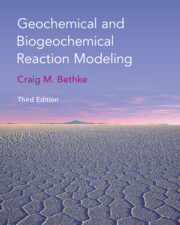Book contents
- Frontmatter
- Dedication
- Contents
- Preface
- Preface to Second Edition
- Preface to First Edition
- A Note About Software
- 1 Introduction
- 2 Modeling Overview
- PART I EQUILIBRIUM IN NATURAL WATERS
- PART II REACTION PROCESSES
- 14 Mass Transfer
- 15 Polythermal, Fixed, and Sliding Paths
- 16 Geochemical Buffers
- 17 Kinetics of Dissolution and Precipitation
- 18 Redox Kinetics
- 19 Microbial Kinetics
- 20 Association and Dissociation Kinetics
- 21 Kinetics of Gas Transfer
- 22 Stable Isotopes
- 23 Transport in Flowing Groundwater
- 24 Reactive Transport
- 25 Stagnant Zones
- PART III APPLIED REACTION MODELING
- Appendix A Sources of Modeling Software
- Appendix B Evaluating the HMW Activity Model
- Appendix C Minerals in the LLNL Database
- Appendix D Nonlinear Rate Laws
- References
- Index
19 - Microbial Kinetics
from PART II - REACTION PROCESSES
Published online by Cambridge University Press: 09 December 2021
- Frontmatter
- Dedication
- Contents
- Preface
- Preface to Second Edition
- Preface to First Edition
- A Note About Software
- 1 Introduction
- 2 Modeling Overview
- PART I EQUILIBRIUM IN NATURAL WATERS
- PART II REACTION PROCESSES
- 14 Mass Transfer
- 15 Polythermal, Fixed, and Sliding Paths
- 16 Geochemical Buffers
- 17 Kinetics of Dissolution and Precipitation
- 18 Redox Kinetics
- 19 Microbial Kinetics
- 20 Association and Dissociation Kinetics
- 21 Kinetics of Gas Transfer
- 22 Stable Isotopes
- 23 Transport in Flowing Groundwater
- 24 Reactive Transport
- 25 Stagnant Zones
- PART III APPLIED REACTION MODELING
- Appendix A Sources of Modeling Software
- Appendix B Evaluating the HMW Activity Model
- Appendix C Minerals in the LLNL Database
- Appendix D Nonlinear Rate Laws
- References
- Index
Summary
The kinetics of microbially catalyzed reactions are of special interest because of the control the reactions exert of the redox state of laboratory experiments and the natural environment. A general description of microbial kinetics must address the requirement of thermodynamic consistency, so the kinetic laws apply equally well far from chemical equilibrium, and close to it. This chapter shows how to formulate thermodynamically consistent rate laws for microbial respiration and fermentation, the process of incorporating such laws into multicomponent chemical reaction models, and a fully worked example demonstrating how such models behave.
Keywords
- Type
- Chapter
- Information
- Geochemical and Biogeochemical Reaction Modeling , pp. 233 - 242Publisher: Cambridge University PressPrint publication year: 2022

